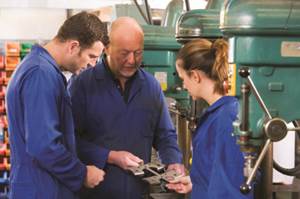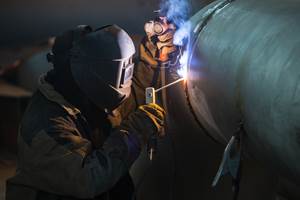The Urgency of Producing a Start-Part
Production cannot begin until the first workpiece is produced and passes inspection.
Under the right circumstances, people who set up CNC machines can complete physical tasks related to making a setup in a predictable and consistent amount of time. Related tasks, like workholding-device preparation, program-zero assignment, cutting tool assembly, offset entry and program loading, among others, do not vary much from one time a given setup is made to the next, especially if needed components are gathered ahead of time.
Verifying programs after completing the physical setup can be another story. While new jobs present the biggest challenges, even often-repeated jobs can be problematic. The single-largest variable is related to the length of time and the number of parts necessary to produce a workpiece that passes inspection. I call this the “start-part.” You cannot begin a production run without it.
In worst-case scenarios, a setup person completes the physical tasks in a reasonable amount of time, oftentimes less than an hour, but hours later, they are still adjusting and running workpieces to produce the start-part. This results in lost time, wasted raw material and disrupted production schedules. This is especially frustrating with repeated jobs that have been run many times.
Program Mean Values of Tolerance Bands
While operators may target something different when making sizing adjustments to increase adjustment intervals, programmers should always specify mean tolerance values for programmed coordinates. Additionally, operators should never change programmed coordinates when making sizing adjustments. Sizing should always be done with offsets. In this way, programmed coordinates remain intact from one time a job is run to the next, and among consecutive jobs. This is critical to first-workpiece inspection because cutting tools that remain in a machine from job to job will continue machining properly in the next job.
Provide Accurate Initial Offset Data
Theoretically, if programed coordinates specify mean values of tolerance bands, and if cutting tool offset data is perfect (like tool length and cutter radius offsets for machining centers and geometry offsets for turning center), then all cutting tools should machine properly, and the first workpiece will be a good one. In reality, offset data is seldom perfect, and other factors, like tool pressure and the quality of workholding and work support, affect how precisely a cutting tool machines on its first try.
The smaller the tolerances that must be held, the more likely a cutting tool will not machine correctly with offset settings determined with static measurements, as when measuring tool-length values with a height gage. That said, the more accurate the initial offset data, the smaller its initial adjustment will be, and the lesser its interactions with other cutting tools. This simplifies the initial adjustment process.
With larger tolerances and if the workpiece is rigidly held and supported, cutting tools with accurately specified offset data will machine properly when first run and will not require adjusting. This is especially true for roughing tools because the amount of finishing stock they allow, though important, is not critical.
Trial Machine for Finishing Cutting Tools
Most machining centers and fixed-headstock turning centers allow setup people to run cutting tools sequentially. If the setup person sizes each cutting tool as it machines the first workpiece, each cutting tool will machine properly, and the first workpiece produced will be a good one. Here is the general process for trial machining:
- Stop and consider what the cutting tool will be doing before it runs.
- M01 (optional stop) is commonly used to make the machine stop after each tool.
- Trial machining is only required for critical/finishing operations.
- Adjust each finishing tool’s offset/s so that the tool leaves additional stock.
- Run the tool, stopping the machine when it is finished.
- Measure the machined surfaces. There will be additional material to remove.
- Adjust the cutting tool’s offset/s based on the target value for the most critical machined surface/s.
- Rerun the cutting tool. This time, machined surfaces will be close to their target values.
- Repeat for each finishing tool.
Ensure That Roughing Tools are Leaving the Correct Amount of Finishing Stock
While roughing tools do not require trial machining, setup people must measure the surfaces they machine to ensure that the proper amount of material is being left for finishing. If they do not, finishing tools may have to machine much more (or much less) material than intended. In either case, the finishing tool will not machine properly.
Look at the Process
With repeated jobs and with our recommended methods, if experienced setup people are constantly struggling to produce a start-part, it should be taken as a signal that the problem may be with machining process. The issue/s could be related to workholding and/or support methods, cutting tool and cutting-condition selection, or machining order.
If a quality control person provides the go-ahead when the workpiece passes inspection, they must understand the related urgency. A CNC machine will remain idle until the first workpiece inspection is done.
Related Content
Understanding The Four Major Behavioral Styles
Companies today are expanding the role of teams in the workplace in an effort to empower employees and improve organizational effectiveness. The more we try to work as a team, the more important it becomes to recognize that people exhibit different behavioral styles.
Read More8 Ways to Increase Productivity on the Manufacturing Floor
When it comes to machine shop productivity, continuous improvement depends on efficient employees, equipment and processes.
Read MoreSelecting The Right Welder
Many machine shops, on occasion, have a need for welding. It may be for maintenance purposes, repair or to fill the odd contract. This story is a welding process primer for those shops whose main business isn't welding but need to know some basics.
Read MoreUnderstanding Errors In Hand-Held Measuring Instruments
Different instruments (and different operators) are prone to different errors.
Read MoreRead Next
The Cut Scene: The Finer Details of Large-Format Machining
Small details and features can have an outsized impact on large parts, such as Barbco’s collapsible utility drill head.
Read More3 Mistakes That Cause CNC Programs to Fail
Despite enhancements to manufacturing technology, there are still issues today that can cause programs to fail. These failures can cause lost time, scrapped parts, damaged machines and even injured operators.
Read MoreObscure CNC Features That Can Help (or Hurt) You
You cannot begin to take advantage of an available feature if you do not know it exists. Conversely, you will not know how to avoid CNC features that may be detrimental to your process.
Read More
.jpg;width=70;height=70;mode=crop)















.png;maxWidth=300;quality=90)









